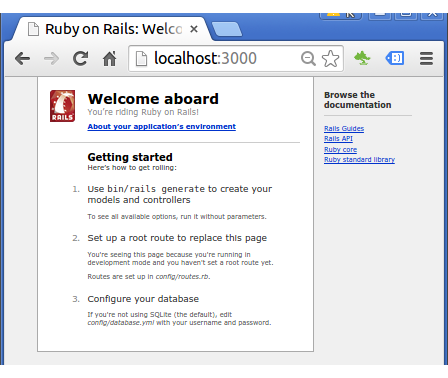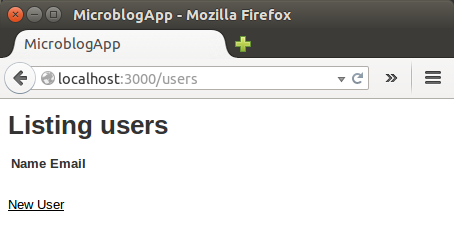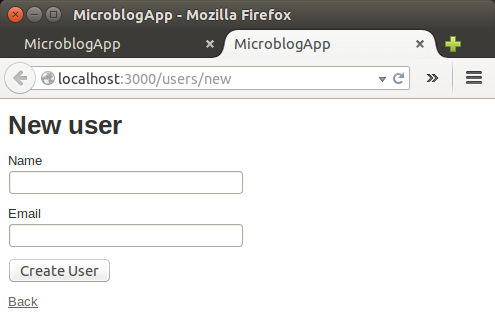Microblog App I 2020

Let's check the versions of ruby and rails:
$ ruby -v ruby 2.1.3p242 (2014-09-19 revision 47630) [x86_64-linux] $ rails -v Rails 4.2.5.1
Almost all Rails applications start by running rails new command. We generate a skeleton Rails application in a directory we choose.
$ cd ~/rails_projects $ $ rails new microblog_app $ cd microblog_app
As we can see rails new automatically runs the bundle install command after the file creation is done. Notice that the rails command creates numerous files and directories.
Typically when we make a web application, first thing we do is creating a data model. The data model is a representation of the structures needed by our application, microblog.
We'll begin with a model for users of the app, and then we'll add a model for microposts.
Users of our microblog app will have a unique integer identifier called id, a publicly viewable name (of type string), and an email address (also a string) that will be used as a username.
Here is the users table:
| users | |
| id | integer |
| name | string |
| string | |
For the users table in database, the id, name, and email attributes are columns in that table.
Our micropost has only an id and a content field for the micropost's text (of type string). We also want to associate each micropost with a particular user by recording the user_id of the owner of the post.
Here is the micropost table:
| microposts | |
| id | integer |
| content | string |
| user_id | integer |
We're going to implement the users data model defined in the earlier section.
The Users resource will allow us to think of users as objects that can be created, read, updated, and deleted (CRUD) through the web via the HTTP protocol. Our Users resource will be created by a scaffold generator which comes standard with each Rails project.
By passing the scaffold command to the rails generate script, we can generate Rails scaffolding. The argument of the scaffold command is the singular form of the resource name, User, together with optional parameters for the data model's attributes.
$ rails generate scaffold User name:string email:string
invoke active_record
create db/migrate/20140519174512_create_users.rb
create app/models/user.rb
invoke test_unit
create test/models/user_test.rb
create test/fixtures/users.yml
invoke resource_route
route resources :users
invoke scaffold_controller
create app/controllers/users_controller.rb
invoke erb
create app/views/users
create app/views/users/index.html.erb
create app/views/users/edit.html.erb
create app/views/users/show.html.erb
create app/views/users/new.html.erb
create app/views/users/_form.html.erb
invoke test_unit
create test/controllers/users_controller_test.rb
invoke helper
create app/helpers/users_helper.rb
invoke test_unit
create test/helpers/users_helper_test.rb
invoke jbuilder
create app/views/users/index.json.jbuilder
create app/views/users/show.json.jbuilder
invoke assets
invoke coffee
create app/assets/javascripts/users.js.coffee
invoke scss
create app/assets/stylesheets/users.css.scss
invoke scss
create app/assets/stylesheets/scaffolds.css.scss
Now, the User model has a form shown in the table above by including name:string and email:string.
The the primary key id in the table is created automatically by Rails.
We need to migrate the database using rake.
We simply update the database with our new users data model:
$ bundle exec rake db:migrate == 20160127231829 CreateUsers: migrating ====================================== -- create_table(:users) -> 0.0125s == 20160127231829 CreateUsers: migrated (0.0164s) =============================
Note that we needed to run rake using bundle exec in order to ensure that the command uses the version of Rake corresponding to our Gemfile.
Now, we can run the local web server using rails server:
$ rails server => Booting WEBrick => Rails 4.2.5.1 application starting in development on http://localhost:3000 => Run `rails server -h` for more startup options => Ctrl-C to shutdown server [2016-01-27 15:23:17] INFO WEBrick 1.3.1 [2016-01-27 15:23:17] INFO ruby 2.1.3 (2014-09-19) [x86_64-linux] [2016-01-27 15:23:17] INFO WEBrick::HTTPServer#start: pid=14445 port=3000
Now our application is ready for http://localhost:3000/.

This root url http://localhost:3000/ page is the same default Rails page we've seen in previous chapter.
Note that we also created a large number of pages for manipulating users.
For example, the page for listing all users is at /users, and the page for making a new user is at /users/new.


Ph.D. / Golden Gate Ave, San Francisco / Seoul National Univ / Carnegie Mellon / UC Berkeley / DevOps / Deep Learning / Visualization